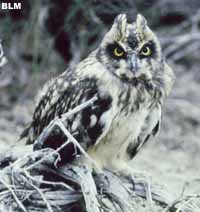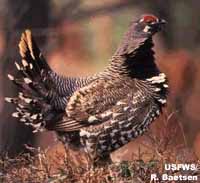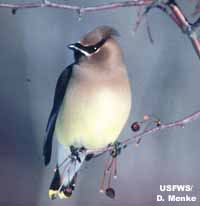Birds are among the most recognized, and charismatic of all
creatures which draw our attention because of their two most
obvious characteristics - flight and feathers. Despite
their superficial similarities, birds which all belong to the Aves
class, have a large number of specialized adaptations and are
separated into 29 separate orders. The
ability to fly is something that birds are specially adapted
to do, even those species that lack the ability.
Adaptations that help birds take to the wing include:
- Wings - size and shape defines the type of flight
(soaring, flying or hovering)
- Flight feathers - barbed design is durable
allowing birds to reshape individual feathers
- "Honeycombed" bones (not present in all
birds) - dramatically lightens skeleton
- Keeled sternum - this is where those enlarged
pectoral (breast) muscles that power flight attach
- Beaks - teeth would be much heavier and have been
replaced with keratin beaks
Beyond being a key identifying feature of birds, feathers
are integral to the structure and survival of birds. In
addition to their functions in flight, feathers also play a
role in insulating birds and are often important to mating
displays.
|
|
Marine and Water Birds
Living and feeding on, near and in the water, birds are a
major component of most marine and aquatic ecosystems.
Birds display an astonishing number of specialized adaptations
to deal with the water, from great blue herons that stalk the
shorelines to albatross that can wonder the skies for days to
weeks at a time to penguins which are unable to fly in the air
but "soar" through the water. From webbed feet to
oiled feathers birds have adapted to live a life that depends
both on the water and upon land. It is marine birds that
migrate the greatest distances of all species with some long
distance birds traveling from the north pole to the south
pole and back each year!
|

Pelicans are a common sight
anywhere fish aggregate. Populations have rebounded steadily
since declines caused by the pesticide DDT.
|
|
Birds of Prey and Owls
Birds of prey and owls are the most accomplished predatory
birds. Examples of birds of prey include hawks, falcons,
vultures and eagles. Birds of prey have keen senses of sight,
powerful legs, and sharp talons and beaks. The eyes of birds
of prey have a high concentration of cone cells which leads to
vision that may allow these birds to see with four times as
much detail as humans. Birds of prey generally spot their prey
with their acute vision and attack and kill their prey with
their sharp talons.
While owls have many similarities to birds of prey, their
hunting is generally at night and they use their offset ears
to pinpoint the location of prey. Specially adapted feathers
allow owls to fly almost silently, while their oversized eyes
are adapted for night vision. Owls are peculiar in that they
don't build their own nests, instead they seek out hollows or
nests used by other birds in years past and lay 2 to 7
eggs. Their young tend to hatch at two day intervals
meaning the oldest chick may be as much as two weeks older
than the youngest.
|

With its distinctive ear tufts or
"horns, the Great Horned Owl is the largest of the
American owls.
|
|
Game Birds
This group is primarily composed of ground-dwelling species
and includes many species that are considered valuable by
people as sources of food. Many of this group have been
domesticated for food or hunted for sport and food. With
heavy bodies these birds are unable to fly great distances and
generally nest on the ground. The powerful wing muscles of
these birds are powerful, enabling these birds to quickly take
to the air. Birds are generally camouflaged so they
blend in well with their surroundings. Clutch sizes are larger
than most other birds with as many as twenty eggs in a
clutch.
|

A relatively tame resident of
the northern boreal forests, the Spruce Grouse is a popular
game bird.
|
|
Non-perching Land Birds
The world of birds extends far beyond the five categories
listed here and most of the rest fall into this catch-all
category. The primary commonality among these species is
that they are relatively unique with only a few species in any
given order. From the tiny hummingbird to the comparatively
gigantic ostrich, birds have specially adapted to a variety of
lifestyles and ecological niches.
(Learn more about
non-passerine land birds!)
|
|
Passerines (Perching Land Birds)
By far the largest and most common order of birds,
passerines are found in all types of terrestrial
habitats. They are frequently found perching in trees,
shrubs or even brush, but some species - like swallows - spend
much of their life in the air. Passerine or perching birds have specially adapted feet
that wrap around branches and other structures such that these
birds can stand on their perches for hours with minimal energy
expenditures. Another distinguishing characteristics of this
order is the well developed voicebox (known as a syrinx).
Passerines are avid singers with the males generally using
songs to proclaim territories or to attract mates. These
perching birds are the type generally found in
backyards and at bird feeders. Feeding on seeds, fruits and
insects, passerine birds are common in most any woodland
setting. While some passerine land birds do remain in
the same area all year, many are what's known as neo-tropical
migrants, feeding and breeding in mid-latitudes during the
summer months and migrating toward the equator when winter
comes.
|

Cedar waxwings feed primarily
on berries, and flocks typically descend on an area and
rapidly strip berry bushes.
|

